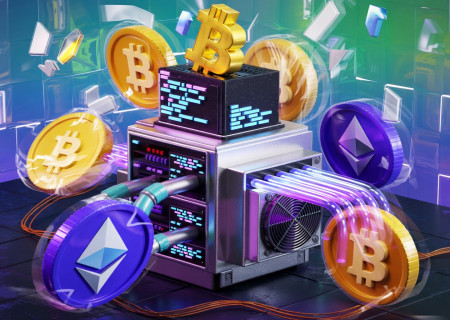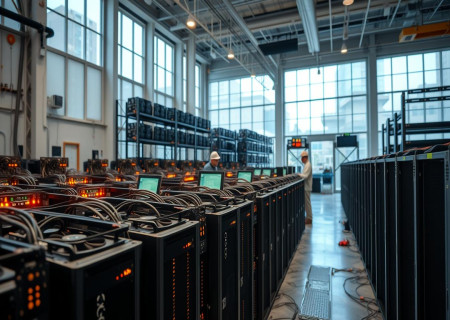
- December 12, 2023
- 2 years ago
Bitcoin Mining Pool vs. Solo Mining – Which One Ensures Better Profitability?
When it comes to earning digital coins, mining remains a top method for Bitcoin enthusiasts. At its core, Bitcoin mining involves verifying blockchain transactions by solving complex mathematical puzzles.
Miners generally have two options to participate in this process. The first is solo mining, where an individual miner uses their own resources to solve these puzzles independently. The second option is joining a Bitcoin mining pool, where multiple miners combine their computing power to work collectively and share the rewards. Deciding which method is more profitable requires understanding their key differences and evaluating which aligns best with your needs.
Exploring Bitcoin Mining Basics
Before comparing mining pools and solo mining, it helps to first grasp the underlying principles of Bitcoin mining. It is the backbone of the Bitcoin network, ensuring its decentralized and secure nature while functioning as a way to introduce new Bitcoins into circulation.
What is Bitcoin Mining?
Bitcoin mining is a process that validates transactions across the blockchain network. It involves solving cryptographic puzzles, which requires high computational power. Miners not only secure the Bitcoin network, but they also earn rewards in the form of newly created Bitcoins and transaction fees.
The Role of Miners in the Network
Miners play a vital role in ensuring the Bitcoin network remains decentralized. They collect, validate, and record transactions on the blockchain by adding them to "blocks." To do this, miners race to solve complex puzzles, with the winner earning Bitcoin rewards. This competition motivates miners to maintain the security and functionality of the network.
Mining Hardware and Essential Needs
The process of mining has undergone significant changes. At first, basic hardware like CPUs could handle the task. Today, however, Application-Specific Integrated Circuits (ASICs) dominate the market due to their unmatched efficiency and processing power. Additionally, miners need significant electricity, cooling mechanisms, and reliable internet connectivity to operate successfully.
Solo Mining Explained
Solo mining is mining in its purest form. Here, miners operate independently, using their own hardware and resources to validate blocks and claim the entire reward.
How Solo Mining Works
Solo miners connect directly to the Bitcoin network using mining software and compete against others in the global network. If they’re the first to solve the puzzle, they validate a block and earn the full reward. Here’s how it works step by step:
- Install and configure mining hardware (ASICs).
- Connect to the blockchain by running Bitcoin client software.
- Attempt to solve cryptographic puzzles.
- Validate transactions and add new blocks to the chain.
Technical Needs for Solo Mining
To succeed in solo mining, miners require robust tools and infrastructure, including:
- High-performance ASIC rigs to process calculations quickly.
- Reliable internet for uninterrupted connectivity to the network.
- Mining software capable of managing the mining process.
- Adequate electricity to power hardware consistently.
Benefits and Challenges of Solo Mining
While solo mining can be extremely rewarding, it comes with its fair share of challenges:
Advantages:
- Full block rewards (including transaction fees).
- Complete independence in mining operations.
- Encourages decentralization of the Bitcoin network.
Challenges:
- Long periods without rewards due to high competition.
- High running costs for hardware and electricity.
- Unpredictable income as success depends on luck and resources.
Unpacking Bitcoin Mining Pools
For miners who prefer collaboration over competition, Bitcoin mining pools offer a less risky alternative. By joining forces with other miners, participants achieve more consistent payouts, albeit at the expense of shared rewards.
What is a Bitcoin Mining Pool?
A mining pool is a group of miners who pool their resources and computational power to mine Bitcoin collectively. Pool participants contribute their hash power to increase the group’s probability of solving a block. Rewards are divided among miners based on their contribution.
Reward Systems in Mining Pools
Mining pools use different methods for distributing rewards among their members, such as:
- Pay-Per-Share (PPS): Every submitted share receives a fixed payout, regardless of whether a block is solved or not.
- Proportional: Rewards are divided proportionally based on the shares submitted during the mining round.
- Score-Based: Rewards consider each miner’s performance and the time of share submission, adjusting payouts accordingly.
Popular pools like Foundry USA, Antpool, and Binance Pool use one or more of these systems to cater to miners’ needs.
Pros and Cons of Mining Pools
Just like solo mining, pool mining has its own set of benefits and limitations:
Pros:
- Steady income through shared rewards.
- Easier entry for miners with limited hashing power.
- Access to a supportive mining community and tools.
Cons:
- Rewards are shared, so individual income is lower per block.
- Mining pools charge fees, which reduce net earnings.
- Centralization risks, as some pools dominate the network.
Pool Mining vs. Solo Mining – Which Is More Profitable?
Profitability comparisons between solo mining and pool mining depend on several factors, such as resource availability, electricity costs, and Bitcoin market dynamics.
Profit Calculation Factors
Key factors determining profitability include:
- Electricity Costs: High consumption impacts both solo and pool mining profits.
- Block Rewards: Miners earn 6.25 BTC per block, excluding transaction fees.
- Mining Difficulty: The tougher the network, the less likely solo miners can find blocks.
- Pool Fees: Mining pools often charge participants 1–4% of earnings to cover maintenance costs.
Consistency of Rewards
The main distinction lies in the consistency of payouts. Solo mining offers higher potential rewards but is unpredictable. Conversely, mining pools deliver frequent, smaller payouts, making them ideal for miners seeking stable income.
| Criteria | Solo Mining | Mining Pools |
|---|---|---|
| Reward Consistency | Low | High |
| Potential Earnings | High | Moderate (shared) |
| Risk Level | High | Low |
Setting Up Your Mining Operation
For Solo Mining:
- Select high-efficiency ASIC hardware.
- Configure mining software to connect directly to the blockchain.
- Ensure cooling systems and a steady power supply.
For Pool Mining:
- Join a reputable bitcoin mining pool with transparent fees.
- Connect your hardware to the pool’s server.
- Monitor your dashboard for performance and rewards.
Final Thoughts
Both solo mining and mining pools have unique advantages and challenges. The choice depends on your scalability and risk tolerance. Solo mining favors those with substantial resources, while mining pools are better suited for individuals looking for consistent and less volatile earnings.
To maximize your mining efforts in any method, focus on reducing power usage, optimizing hardware, and staying updated with market changes.
FAQs
What’s the difference between solo mining and pool mining?
Solo mining involves mining independently, while pool mining combines efforts with others.
Why are mining pools more consistent?
By pooling resources, miners earn regular payouts based on collective efforts.
Which option is more profitable?
Pool mining is more predictable, while solo mining has higher potential rewards but greater risks.
What should I consider when choosing a mining method?
Factor in electricity costs, hardware efficiency, and your financial objectives.




